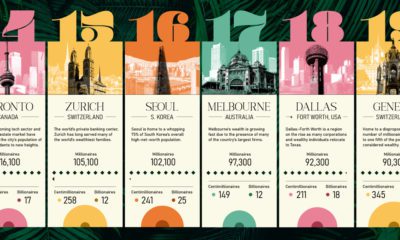Over his lifetime, Buffett has built Berkshire Hathaway into one of the biggest companies in American history, amassed a personal fortune of over $80 billion, and earned acclaim as one of the world’s foremost philanthropists. But in a 75-year career, it’s no surprise that even Buffett has made the odd blunder – and there’s one that he claims has ultimately costed him an estimated $200 billion!
The Warren Buffett Series
Part 4: Buffett’s Biggest Wins and Fails
Today’s infographic highlights Buffett’s investing strokes of genius, as well as a few decisions he would take back. It’s the fourth part of the Warren Buffett Series, which we’ve done in partnership with finder.com, a personal finance site that helps people make better decisions – whether they want to dabble in cryptocurrencies or become the next famous value investor. Note: New series parts will be released intermittently. Stay tuned for future parts with our free mailing list. How did Buffett go from local paperboy to the world’s most iconic investor? Here are the backstories behind five of Warren’s biggest acts of genius. These are the events and decisions that would propel his name into investing folklore for centuries to come.
Buffett’s 5 Biggest Wins
From making shrewd value investing calls to taking advantage of misfortune in the salad oil market, here are some of the stories that are Buffett classics:
- GEICO (1951) At 20 years old, Buffett was attending Columbia Business School, and was a student of Benjamin Graham’s. When young Buffett learned that Graham was on the board of the Government Employees Insurance Company (GEICO), he immediately took a train to Washington, D.C. to visit the company’s headquarters. On a Saturday, Buffett banged on the door of the building until a janitor let him in, and Buffett met Lorimer Davidson – the future CEO of GEICO. Ultimately, Davidson spent four hours talking to this “highly unusual young man”. – Warren Buffett By Monday, Buffett was “more excited about GEICO than any other stock in [his] life” and started buying it on the open market. He put 65% of his small fortune of $20,000 into GEICO, and the money he earned from the deal would provide a solid foundation for Buffett’s future fortune. Although Buffett sold GEICO after locking in solid gains, the stock would rise as much as 100x over time. Buffett bought his favorite stock again a few years later, loaded up further during the 1970s, and eventually bought the whole company in the 1990s.
- Sanborn Maps (1960) This early deal may not be Buffett’s biggest – but it’s the clearest case of Benjamin Graham’s influence on his style. Sanborn Maps had a lucrative business around making city maps for insurers, but eventually its mapping business started dying – and the falling stock price reflected this trend. Buffett, after diving deep into the company’s financials, realized that Sanborn had a large investment portfolio that was built up over the company’s stronger years. Sanborn’s stock was worth $45 per share, but the value of the company’s investments tallied to $65 per share. In other words, these investments held by the company were alone worth more than the stock – and that didn’t include the actual value of the map business itself! Buffett accumulated the stock in 1958 and 1959, eventually putting 35% of his partnership assets in it. Then, he became a director, and convinced other shareholders to use the investment portfolio to buy out stockholders. He walked away with a 50% profit.
- The Salad Oil Swindle (1963) For a value investor like Buffett, every mishap is a potential opportunity. And in 1963, a con artist named Anthony “Tino” De Angelis inadvertently set Buffett up for a massive home run. After De Angelis attempted to corner the soybean oil market using false inventories and loans, the market subsequently collapsed. American Express – the world’s largest credit card company at the time – got caught up in the disaster, and its stock price halved as investors thought the company would fail. Although everyone else panicked, Buffett knew the scandal wouldn’t affect the overall value of the business. He was right – and bought 5% of American Express for $20 million. By 1973, Buffett’s investment increased ten times in value.
- Capital Cities / ABC (1985) In the 1980s, corporate raiders and takeover madness reigned supreme. The massive TV network ABC found itself vulnerable, and sold itself to a company that promised to keep its legacy intact. Capital Cities, a relative unknown and a fraction of the size, had somehow managed to buy ABC. The CEO of Cap Cities, Tom Murphy – one of Buffett’s favorite managers in the world – gave Warren a call: – Tom Murphy, Capital Cities CEO Berkshire dropped $500 million to finance the deal. This turned Buffett into Murphy’s much-needed “900-lb gorilla” – a loyal shareholder that would hold onto shares regardless of price, as Murphy figured out how to turn the company around. It turned out to be a fantastic gamble for Buffett, as Capital Cities/ABC sold to Disney for $19 billion in 1995.
- Freddie Mac (1988) Buffett started loading up on shares of Freddie Mac in 1988 for $4 per share. By 2000, Buffett noticed the company was taking unnecessary risks to deliver double-digit growth. This risk, and its short-term focus, turned Buffett off the company. As a result, at a share price close to $70, he sold virtually all of his holdings, enjoying a return of more than 1,500%. – Warren Buffett Later on, Freddie Mac’s business would collapse in the housing crisis, only to be taken over by the U.S. federal government. Today, its stock sells for a mere $1.50 per share.
Buffett’s Blunders
Over the course of 75 years, it’s not surprising that even Buffett has made some serious mistakes. Here are his costliest ones:
- Berkshire Hathaway (1962) When Buffett first invested in Berkshire Hathaway, it was a fledgling textile company. Buffett eventually tried to pull out, but the company changed the terms of the deal at the last minute. Buffett was spiteful, and loaded up with enough stock to fire the CEO that deceived him. The textiles business was terrible and sucked up capital – and Berkshire unintentionally would become Buffett’s holding company for other deals. This mistake, he estimates, costed him an estimated $200 billion.
- Dexter Shoes (1993) Dexter Shoe Co. had a long, profitable history, an enduring franchise, and suberb management. In other words, it was the exact kind of company Buffett liked. Buffett dropped $433 million in 1993 to buy the company, but the company’s competitive advantage soon waned. To make matters worse, Warren Buffett financed the deal with Berkshire’s own stock, compounding the mistake hugely. It ended up costing the company $3.5 billion. – Warren Buffett Later on, Buffett would say that this deal deserved a spot in the Guinness Book of World Records as a top financial disaster. – Warren Buffett
on Last year, stock and bond returns tumbled after the Federal Reserve hiked interest rates at the fastest speed in 40 years. It was the first time in decades that both asset classes posted negative annual investment returns in tandem. Over four decades, this has happened 2.4% of the time across any 12-month rolling period. To look at how various stock and bond asset allocations have performed over history—and their broader correlations—the above graphic charts their best, worst, and average returns, using data from Vanguard.
How Has Asset Allocation Impacted Returns?
Based on data between 1926 and 2019, the table below looks at the spectrum of market returns of different asset allocations:
We can see that a portfolio made entirely of stocks returned 10.3% on average, the highest across all asset allocations. Of course, this came with wider return variance, hitting an annual low of -43% and a high of 54%.
A traditional 60/40 portfolio—which has lost its luster in recent years as low interest rates have led to lower bond returns—saw an average historical return of 8.8%. As interest rates have climbed in recent years, this may widen its appeal once again as bond returns may rise.
Meanwhile, a 100% bond portfolio averaged 5.3% in annual returns over the period. Bonds typically serve as a hedge against portfolio losses thanks to their typically negative historical correlation to stocks.
A Closer Look at Historical Correlations
To understand how 2022 was an outlier in terms of asset correlations we can look at the graphic below:
The last time stocks and bonds moved together in a negative direction was in 1969. At the time, inflation was accelerating and the Fed was hiking interest rates to cool rising costs. In fact, historically, when inflation surges, stocks and bonds have often moved in similar directions. Underscoring this divergence is real interest rate volatility. When real interest rates are a driving force in the market, as we have seen in the last year, it hurts both stock and bond returns. This is because higher interest rates can reduce the future cash flows of these investments. Adding another layer is the level of risk appetite among investors. When the economic outlook is uncertain and interest rate volatility is high, investors are more likely to take risk off their portfolios and demand higher returns for taking on higher risk. This can push down equity and bond prices. On the other hand, if the economic outlook is positive, investors may be willing to take on more risk, in turn potentially boosting equity prices.
Current Investment Returns in Context
Today, financial markets are seeing sharp swings as the ripple effects of higher interest rates are sinking in. For investors, historical data provides insight on long-term asset allocation trends. Over the last century, cycles of high interest rates have come and gone. Both equity and bond investment returns have been resilient for investors who stay the course.



















